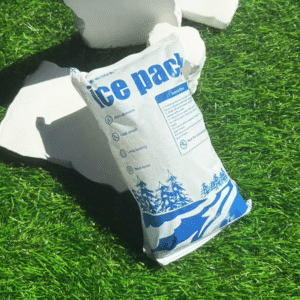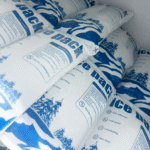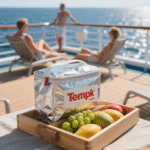Shipping perishable goods across the country requires careful planning, especially when packs de glace sec are involved. Glace sèche, la forme solide de dioxyde de carbone, sublimates directly into gas at -78.5°C (-109.3°F), making it an ideal coolant for maintaining sub-zero temperatures during transit. Cependant, improper handling, conditionnement, or failure to meet regulatory requirements can lead to spoilage, safety hazards, or non-compliance. This guide provides you with the latest best practices for shipping with dry ice packs, the necessary regulatory updates, and safety tips to ensure smooth operations.
-
What are dry ice packs and how do they work for shipping cross-country?
-
How can dry ice packs maintain the required temperature during long-distance shipments?
-
What are the benefits of using dry ice for shipping perishable goods across the country?
-
How can businesses effectively implement dry ice in their logistics for cross-country shipments?
What Are Dry Ice Packs and How Do They Work for Shipping Cross-Country?
Les packs de glace sec sont un dioxyde de carbone solidifié (Co₂) used to keep perishable items frozen during transport. Contrairement à la glace traditionnelle, dry ice sublimates directly into a gas, eliminating any risk of water damage. This unique property makes dry ice especially valuable in shipping temperature-sensitive goods like food, médicaments, et les produits biotechnologiques. During a cross-country shipment, the cooling effect of dry ice ensures that products are kept at the required temperature until they reach their destination.
Dry ice sublimates at a consistent rate, which helps in maintaining cold temperatures for an extended period, typically between 24–48 hours depending on the amount used and the insulation quality. For cross-country shipments, this duration is generally sufficient to ensure that goods remain frozen or chilled without any risk of spoilage.
How Dry Ice Packs Maintain Temperature During Long-Distance Shipments
The process of sublimation is the key to dry ice’s effectiveness in temperature control. As solid CO₂ turns into gas, it absorbs heat from the surrounding environment, thereby keeping the interior of the package cold. This gradual and consistent cooling effect ensures that products remain within the desired temperature range without the risk of thawing or spoilage during transport.
For cross-country shipments, where deliveries can take 24–72 hours, dry ice is the preferred choice due to its ability to maintain sub-zero temperatures over extended periods.
| Méthode de contrôle de la température | Laps de temps | Efficacité | Application pratique |
|---|---|---|---|
| Packs de glace sec | 24-48 heures | Haut | Ideal for long-distance, marchandises sensibles à la température |
| Packs de gel | Varie | Modéré | Best for short distances or less sensitive items |
| Packs de glace | Varie | Low to Moderate | Suitable for sturdier products with some tolerance for temperature fluctuations |
What Are the Benefits of Using Dry Ice in Cold Chain Shipping?
Dry ice is widely regarded as one of the most effective cooling methods for temperature-sensitive shipments. The benefits of using dry ice include:
Efficient Temperature Control
Dry ice offers unparalleled cooling power, keeping goods frozen at temperatures as low as -78.5°C (-109.3°F). This makes it ideal for shipping perishable food, vaccins, and medical supplies that need to remain frozen during transit. Contrairement à la glace traditionnelle, la neige carbonique se sublime en gaz, leaving no liquid residue and preventing potential contamination.
Puissance de refroidissement durable
Dry ice can maintain sub-zero temperatures for a significant period, making it perfect for long-distance shipments. The ability to keep products frozen for up to 48 hours ensures that even long-haul cross-country shipments can maintain their integrity without the risk of thawing.
Rentabilité
Although dry ice may initially appear expensive, it is often more cost-effective than other methods. By reducing spoilage and maintaining product quality, businesses can lower overall shipping costs and minimize losses from product damage.
Best Practices for Packing Dry Ice for Cross-Country Shipping
Proper packing is essential to ensure the safe and efficient transport of goods with dry ice. Below are the best practices for packing dry ice for cross-country shipments:
-
Select Appropriate Packaging Materials:
-
Outer Container: Use rigid, vented containers such as corrugated cardboard boxes to allow CO₂ gas to escape. Avoid airtight seals that could lead to pressure buildup.
-
Isolation: Choose insulation materials like polystyrene foam or thermal liners to reduce sublimation rates and maintain temperature.
-
Scellage: Secure the seams of your packaging using the H-taping method to ensure it remains intact during transit.
-
-
Properly Arrange Contents:
-
Superposition: Place a layer of dry ice at the bottom of the container and another layer on top of the product.
-
Spacing: Fill any voids with packing materials such as bubble wrap or packing peanuts to prevent movement and minimize sublimation.
-
-
Étiquetage et documentation:
-
Marques: Clearly label the package with “Glace sèche” ou “Dioxyde de carbone, Solide,” Et 1845, and indicate the net weight of the dry ice in kilograms.
-
Hazard Label: Attach a Class 9 hazard label for air shipments to ensure proper handling during transport.
-
Regulatory Requirements for Shipping Dry Ice
Compliance with current shipping regulations is essential to ensure safe and legal transport.
Domestic Shipping (NOUS.)
-
Air Transport: Dry ice shipments by air are regulated as hazardous materials. The maximum weight allowed per package is 5 livres (2.27 kg) for air transport.
-
Conditionnement: Vented containers must be used to prevent pressure buildup.
-
Étiquetage: Packages must include the UN 1845 étiquette, poids net en kilogrammes, Et une classe 9 étiquette de danger.
Expédition internationale
-
Documentation: Pour les expéditions internationales, a Shipper’s Declaration for Dangerous Goods may be required.
-
Carrier Policies: Always verify the carrier’s specific requirements and restrictions.
Future Trends in Dry Ice Shipping for 2025
As the shipping industry evolves, several trends are shaping the future of dry ice logistics:
-
Durabilité dans l'emballage: The use of biodegradable and recyclable materials is on the rise to reduce the environmental impact of packaging.
-
Surveillance intelligente: The integration of IoT devices for real-time temperature and location tracking provides enhanced visibility and control over shipments.
-
Regulatory Updates: Continuous updates to shipping regulations ensure improved safety and efficiency.
Conclusion et recommandations
Shipping perishable goods with dry ice requires careful attention to packaging, étiquetage, et conformité réglementaire. By following best practices and staying informed about industry trends, businesses can ensure that their temperature-sensitive shipments are delivered safely and efficiently.
Étapes suivantes
-
Evaluate your shipment profile: Consider the nature of the goods and the shipping method (Air ou terre) that best suits your needs.
-
Optimize packaging and insulation: Choose materials that will maintain the required temperature for the duration of the shipment.
-
Stay updated on regulations: Ensure that your team is well-informed about the latest shipping regulations and safety protocols.
À propos du tempk
Et tempk, nous sommes spécialisés dans la fourniture de solutions innovantes pour la chaîne du froid, y compris les packs de glace sec de haute qualité. Our products are designed to meet the stringent requirements of various industries, ensuring the safe and efficient transport of temperature-sensitive goods. Pour plus d'informations ou pour passer une commande, visit our website or contact our customer service team.
























